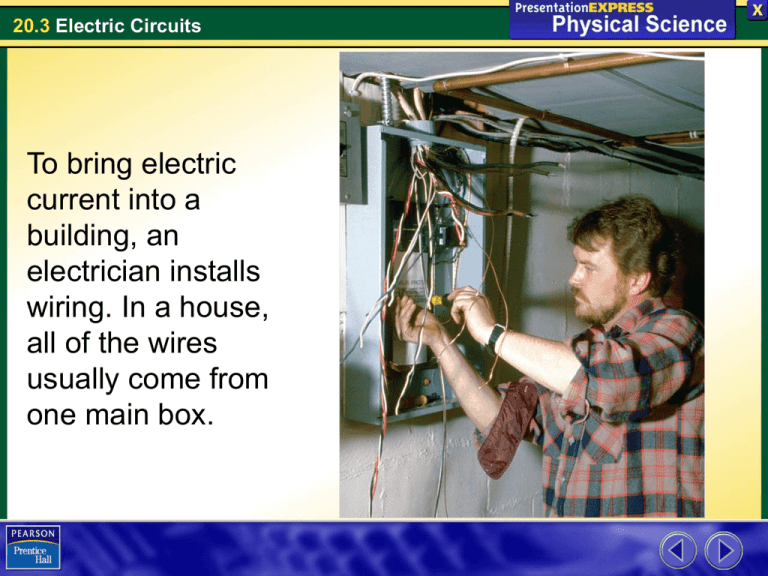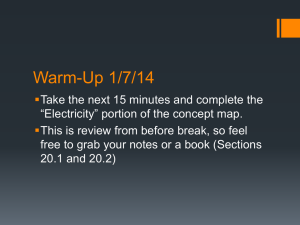20.3 Electric Circuits
advertisement

20.3 Electric Circuits To bring electric current into a building, an electrician installs wiring. In a house, all of the wires usually come from one main box. 20.3 Electric Circuits Circuit Diagrams What is included in a circuit diagram? Circuit diagrams use symbols to represent parts of a circuit, including a source of electrical energy and devices that are run by the electrical energy. 20.3 Electric Circuits Circuit Diagrams An electric circuit is a complete path through which charge can flow. • A circuit diagram shows one or more complete paths in which charge can flow. • Arrows show the direction of current, from positive to negative. The direction of current is defined as the direction in which positive charges would flow, but electrons flow in the opposite direction. 20.3 Electric Circuits Circuit Diagrams Switches show places where the circuit can be opened. • If a switch is open, the circuit is not a complete loop, and current stops. This is called an open circuit. • If the switch is closed, the circuit is complete, and charge can flow. This is called a closed circuit. 20.3 Electric Circuits Series Circuits How do series and parallel circuits differ? If one element stops functioning in a series circuit, none of the elements can operate. If one element stops functioning in a parallel circuit, the rest of the elements still can operate. 20.3 Electric Circuits Series Circuits In a series circuit, charge has only one path through which it can flow. • If one bulb burns out in a series circuit, it becomes an open circuit. • The bulbs in a circuit are a source of resistance. Adding bulbs to a series circuit increases the resistance. The current decreases, and each bulb shines less brightly. 20.3 Electric Circuits Series Circuits A series circuit has one path that each charge can follow. 20.3 Electric Circuits Parallel Circuits A parallel circuit is an electric circuit with two or more paths through which charges can flow. • If one bulb in a parallel circuit burns out, charge still flows along the other path, and the other bulb stays lit. • In a home, electric circuits are wired in parallel so they can operate independently. 20.3 Electric Circuits Parallel Circuits A parallel circuit has more than one path each charge can follow. 20.3 Electric Circuits Parallel Circuits Most circuits in a house are parallel. Even if one device stops working, the others will still work. 20.3 Electric Circuits Power and Energy Calculations How do you calculate electric power and electrical energy use? Electric power can be calculated by multiplying voltage by current. 20.3 Electric Circuits Power and Energy Calculations The rate at which electrical energy is converted to another form of energy is electric power. Recall that power is the rate of doing work. The unit of electric power is the joule per second, or watt (W). Power often is measured in thousands of watts, or kilowatts (kW). 20.3 Electric Circuits Power and Energy Calculations Calculating Electric Power An electric oven is connected to a 240-volt line, and it uses 34 amps of current. What is the power used by the oven? 20.3 Electric Circuits Power and Energy Calculations Read and Understand What information are you given? 20.3 Electric Circuits Power and Energy Calculations Read and Understand What information are you given? 20.3 Electric Circuits Power and Energy Calculations Plan and Solve What unknown are you trying to calculate? What formula contains the given quantities and the unknown? 20.3 Electric Circuits Power and Energy Calculations Plan and Solve What unknown are you trying to calculate? What formula contains the given quantities and the unknown? 20.3 Electric Circuits Power and Energy Calculations Plan and Solve Replace each variable with its known value. 20.3 Electric Circuits Power and Energy Calculations Plan and Solve Replace each variable with its known value. 20.3 Electric Circuits Power and Energy Calculations Look Back and Check Is your answer reasonable? 20.3 Electric Circuits Power and Energy Calculations Look Back and Check Is your answer reasonable? The answer is reasonable because an electric oven should use much more power than a 1875-watt hair dryer. 20.3 Electric Circuits Power and Energy Calculations 1. A clothes dryer uses about 27 amps of current from a 240-volt line. How much power does it use? Answer: 20.3 Electric Circuits Power and Energy Calculations 1. A clothes dryer uses about 27 amps of current from a 240-volt line. How much power does it use? Answer: P = I × V = (240 V)(27 A) = 6500 W 20.3 Electric Circuits Power and Energy Calculations 2. A camcorder has a power rating of 2.3 watts. If the output voltage from its battery is 7.2 volts, what current does it use? Answer: 20.3 Electric Circuits Power and Energy Calculations 2. A camcorder has a power rating of 2.3 watts. If the output voltage from its battery is 7.2 volts, what current does it use? Answer: I = P/V = (2.3 W)/(7.2 V) = 0.32 A 20.3 Electric Circuits Power and Energy Calculations 3. A power tool uses about 12 amps of current and has a power rating of 1440 watts. What voltage does the tool require? Answer: 20.3 Electric Circuits Power and Energy Calculations 3. A power tool uses about 12 amps of current and has a power rating of 1440 watts. What voltage does the tool require? Answer: V = P/I = (1440 W)/(12 A) =120 V 20.3 Electric Circuits Power and Energy Calculations An appliance's power rating lets you know how much power it uses under normal conditions. An electric stove uses about 6000 watts, and a microwave oven uses about 1000 watts. Find the electrical energy used by an appliance by multiplying power by time. 20.3 Electric Circuits Power and Energy Calculations The power rating of a typical clothes dryer is 5400 watts, or 5.4 kilowatts. If you use the clothes dryer for 2 hours, the energy use is 5.4 kilowatts multiplied by 2 hours, or 10.8 kilowatt-hours. A kilowatt-hour equals 3,600,000 joules. 20.3 Electric Circuits Electrical Safety What devices make electricity safe to use? Correct wiring, fuses, circuit breakers, insulation, and grounded plugs help make electrical energy safe to use. 20.3 Electric Circuits Electrical Safety Correct wiring is not enough to prevent electrical accidents. Most household circuits usually have an average voltage of 120 volts. Each device that is turned on increases the current. If the current exceeds the circuit’s safety limit, the wire may overheat. 20.3 Electric Circuits Electrical Safety Home Safety A fuse prevents current overload in a circuit. A wire in the center of the fuse melts if too much current passes through it. A circuit breaker is a switch that opens when current in a circuit is too high. The circuit breaker must be reset before the circuit can be used again. 20.3 Electric Circuits Electrical Safety Fuses have an internal wire that burns out if a current is too great. 20.3 Electric Circuits Electrical Safety Personal Safety Electrical wiring in a home is insulated to protect people. If the insulation is damaged, you may accidentally touch the bare wire and get a shock. Avoid touching electrical devices with wet hands, because your hands conduct current more readily when they are wet. 20.3 Electric Circuits Electrical Safety Insulation also prevents short circuits. A three-prong plug can prevent shocks caused by short circuits. If a short circuit develops, the current takes an easier path to ground through the grounding wire. The transfer of excess charge through a conductor to Earth is called grounding. 20.3 Electric Circuits Electrical Safety A ground-fault circuit interrupter (GFCI) is an electrical safety outlet. It monitors current flowing to and from an outlet or appliance. If these two currents are not equal, it means current is escaping. The GFCI opens the circuit to prevent serious electric shocks. 20.3 Electric Circuits Electrical Safety Even a small current in your body can cause a painful shock or injury. Ground-fault circuit interrupter (GFCI) 20.3 Electric Circuits Assessment Questions 1. A number of light bulbs are connected to an energy source in a series circuit. What will happen to the other bulbs if one of the bulbs burns out? a. b. c. d. Nothing will happen. They will be brighter. They will be dimmer. They will turn off. 20.3 Electric Circuits Assessment Questions 1. A number of light bulbs are connected to an energy source in a series circuit. What will happen to the other bulbs if one of the bulbs burns out? a. b. c. d. Nothing will happen. They will be brighter. They will be dimmer. They will turn off. ANS: D 20.3 Electric Circuits Assessment Questions 2. A pair of 15-watt computer speakers are connected to a 12-volt power supply. What is the electric current running through the speakers? a. b. c. d. 0.8 A 1.25 A 12.5 A 180 A 20.3 Electric Circuits Assessment Questions 2. A pair of 15-watt computer speakers are connected to a 12-volt power supply. What is the electric current running through the speakers? a. b. c. d. 0.8 A 1.25 A 12.5 A 180 A ANS: B 20.3 Electric Circuits Assessment Questions 1. A ground-fault circuit interrupter is a switch that opens to prevent overheating when the current in a circuit is too high. True False 20.3 Electric Circuits Assessment Questions 1. A ground-fault circuit interrupter is a switch that opens to prevent overheating when the current in a circuit is too high. True False ANS: F, circuit breaker






